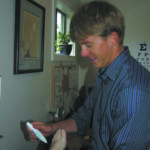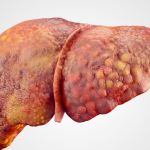Walking the Tightrope: Diabetes Management in Naturopathic Primary Care
Ryan Bradley, ND
Diabetes, both Type I and Type II, offers model chronic conditions for naturopathic physicians to explore the potential to provide primary care. The education on lifestyle change and self-management delivered by most naturopathic physicians in the clinical setting could not fill a more gaping chasm than the one created by routine allopathic care in the treatment of diabetes. As many patients come to naturopathic physicians seeking alternatives and replacements for prescription medications, it is important to fully grasp the consequences of poor glycemic control when advising patients toward or away from conventional medications.
Diabetes is extremely complex and time consuming to manage appropriately, requiring constant attention to clinical management and treatment to ensure the best possible care for patients. Complications of diabetes are common and severe, many being present at the time of diagnosis. Therefore, attention to optimal care in diabetes begins at screening and diagnosis, continues through appropriate laboratory evaluation on schedule, and ultimately incorporates self- and physician-directed treatment. Dietary advice, given with the best possible intentions and backed by sound theory, needs to be specific to each patient, considering not only short-term glycemic status, but also renal functioning and long-term disease progression. Some treatments, like exogenous insulin therapy, are stigmatized as a point of no return for many patients, but may in fact be the most indicated treatment for a patient in poor glycemic control or who is unresponsive to oral medications and supplementation. While there are limitations and biases inherent in the push for evidence-based medicine, there are also ethical considerations to evaluate when making recommendations in contrast to research-supported guidelines. These decisions must include a discussion of the risk-to-benefit ratio and an accurate discussion of informed consent with patients.
As naturopathic medicine is a unique system of medicine, defined by its philosophy and not by its therapies, the principals of naturopathic medicine can enter the clinical conversation regardless of whether you are simply ordering appropriate testing, prescribing the hottest nutritional supplement or recommending initiation of insulin therapy. Since both pharmaceutical and nutraceutical companies promote treatments without adequate data, it becomes the responsibility of the provider to remove the propaganda and tempting theories from the clinical advice on which our patients rely.
The Impact of Diabetes
According to the American Diabetes Association (ADA, 2006), approximately 20.8 million people have diabetes in the U.S. today, although an estimated 40% are not aware they have the condition. Diabetes remains the sixth-leading cause of death in the U.S., and the leading cause of adult blindness and non-traumatic amputation. Microvascular disease also leads to end-stage renal disease, painful peripheral and serious autonomic neuropathies (e.g., gastroparesis, cardiac arrhythmia) when not prevented by tight glycemic control. People with diabetes are at two- to three-fold risk of death due to cardiovascular disease, and approximately 83% of people with diabetes die of myocardial infarction and/or complications of congestive heart failure.
Current Care for Diabetes
Primary care providers (PCP) treat and manage 82% of diabetes care in the U.S.; thus, the importance of naturopathic physicians learning appropriate diagnostics and management for this common and complex condition is critical in our emerging role as PCPs in some states. Evaluation of the National Health And Nutrition Examination Survey (NHANES) (Saydeh, 2004) data from 1999-2000 demonstrated that only 37% of people with Type II diabetes were in good glycemic control (per ADA definition of hemoglobin A1c <7%). While there are limitations to any survey, these statistics are alarming, especially in the context of a $132-billion annual health care cost. Recent studies suggest only 25% of people with diabetes can accurately report their hemoglobin A1c.
Diagnostics
The diagnosis of Type II diabetes is based on meeting one of three criteria:
- Two fasting venous blood glucose measurements > 126 mg/dl
- Two-hour post 75 gram oral glucose tolerance test; glucose > 200 mg/dL
- Random venous blood glucose measurement > 200 mg/dL.
Note that these criteria are based on venous blood, not on home glucometer readings. Also note that currently there is no diagnostic criterion based on hemoglobin A1c. At this time, it is recommended that screening be performed on at-risk individuals using a fasting glucose measurement, not an A1c or oral glucose tolerance test (OGTT). This recommendation may change in the near future, as it becomes more apparent that individuals from certain ethnic groups (African American, Hispanic/Latino) demonstrate impaired glucose tolerance earlier than impaired fasting glucose, leading to earlier diagnosis. Some clinicians are concerned about diagnosing patients with diabetes, as the diagnosis can carry a stigma and has implications on medical and life insurance. While this may be true in some circumstances, making the diagnosis is important for appropriate medical services to get covered by insurers and can be important for the patient’s understanding of the gravity of the situation.
Assessment
Many components are required in the provision of complete medical care for a person with diabetes. Upon diagnosis, the following should be performed or recommended:
- Hemoglobin A1c (repeat quarterly)
- Total cholesterol, LDL, HDL, triglycerides (repeat regularly until at target, then annually)
- Routine chemistry for liver function test (LFT) elevation, BUN elevation and serum creatinine (repeat annually)
- UA and urine albumin-to-creatinine ratio (repeat annually unless abnormal)
- Referral for a dilated eye exam by a retinal specialist (repeat annually or semi-annually)
- Consider in-office EKG and/or baseline cardiology evaluation, especially if you are going to prescribe exercise to a previously sedentary patient
- Perform a thorough multi-system physical exam, including neurologic assessment with monofilament testing and vibratory sense (quarterly or semi-quarterly).
Important Considerations
Glomerular filtration rate (GFR) can be compromised, even if serum creatinine is normal, especially in the elderly and ethnic populations. GFR can be estimated a number of ways without direct measurement, using free online calculators and/or a pocket slide calculator. Tight blood pressure control becomes even more critical when GFR is reduced.
Urine albumin-to-creatinine ratio is a critical assessment to make, and is often overlooked. Albumin losses can be substantial from the kidney upon diagnosis and typically are greater with higher blood glucose. Normalizing blood glucose and aggressive blood pressure control (<125/75) are critical to slow progression of nephropathy. Definitions for microalbuminuria vs. albuminuria are available from the ADA (2006). Progression from frank albuminuria to end-stage renal disease (ESRD) is very rapid, with most patients progressing within five years. In conventional medicine, ACE-inhibitors and angiotension receptor blockers (ARBs) are the standard of care, because clinical trials have demonstrated slower progression from microalbuminuria to albuminuria when these drugs are used. Dietary protein should be limited to 0.8g/kg body weight to avoid increased protein load on the kidneys. Similarly, excessive hydration can cause hyperfiltration.
Exercise prescription should be done systematically using the FITT acronym (F=Frequency I=Intensity T=Type T=Timing) as a guide. Exercise can increase renal protein filtration. Caution is warranted if the patient reports, or if you detect, any neurologic compromise, as autonomic neuropathy can compromise the heart rate variability and pulmonary drive needed to sustain exercise. Patients using insulin need to be cautious when beginning exercise, as dose adjustments will be necessary and more frequent home monitoring is recommended. In some cases, a supervised exercise program can be the best option for safe exercise, especially in patients with severe neuropathy, past history of myocardial infarction or current symptoms of congestive heart failure.
Treatment Goal
The goal of treatment is prevention of both macro- and micro-vascular complications. The main cause of death in patients with diabetes is macrovascular disease; however, microvascular disease (retinopathy, neuropathy, nephropathy, erectile dysfunction, etc.) is more common and debilitating. Aggressive control of hyperglycemia, lipids and blood pressure are all proven to reduce the risk of death and complications in patients with diabetes. According to the ADA (2006), the following are principal targets for treatment:
- Hemoglobin A1c <7% (4%-6% is the normal range)
- Blood pressure <130/80
- HDL >40 mg/dL
- LDL <100 mg/dL (or 30% reduction in LDL if >40 years of age, with total cholesterol >135 mg/dL)
- Triglycerides <150 mg/dL.
These recommendations are based on large clinical trials demonstrating reduction in cardiac events and/or mortality. The United Kingdom Prospective Diabetes Study (UKPDS) (Stratton et al., 2000) demonstrated that for every 1% reduction in hemoglobin A1c, the patient reduces his or her risk of death, myocardial infarction and microvascular complications by 21%. Every reduction in blood glucose reduces risk. The blood pressure control group of the UKPDS demonstrated 32%-47% reductions in stroke, diabetes-related death and microvascular disease by achieving blood pressure reductions of <144/82. The Heart Protection Study (Collins et al., 2003) demonstrated a 25% reduction in first coronary event by achieving a 30% reduction in LDL cholesterol (using a statin in this study) in patients with diabetes greater than 40 years of age with total cholesterol >135 mg/dL. This risk reduction was independent of baseline LDL, degree of glycemic control, type or duration of diabetes, or pre-existing coronary disease. These findings have led to a secondary target for LDL cholesterol <70 mg/dL.
Conclusion
Naturopathic physicians are valuable additions in the care of patients with diabetes. Our emphasis on physician-directed, therapeutic lifestyle and behavioral changes is unparalleled in current health care delivery. Although patients with diabetes are a complex population to manage, the necessary assessments are well within the training of current naturopathic education. While in some states naturopathic physicians may be limited in their ability to directly order laboratory testing and/or make referrals, this limitation does not supercede the ability to educate the patient on the need for these tests, etc., and advocate for the patient when necessary. The more we educate our patients on appropriate monitoring and assessment, the more empowered they become to make informed health care decisions. In addition, the results of this evaluation have impact on the prescription of exercise and dietary recommendations we make to our patients. Giving recommendations without complete knowledge of a patient’s glycemic, cardiovascular and renal status may cause harm, including delay of needed treatment. Much more research is required to investigate the contribution of naturopathic medicine in the care of this vulnerable population. First, do no harm.
References
American Diabetes Association (ADA): www.diabetes.org.
Saydeh S: Poor control of risk factors for vascular disease among adults with previously diagnosed diabetes, JAMA 291(3): 335-342, 2004.
American Diabetes Association. Standards of Medical Care for Patients with Diabetes Mellitus, Diabetes Care Jan. 29(s1), 2006.
Stratton IM et al: Association of glycemia with macrovascular and microvascular complications of type 2 diabetes (UKPDS 35): prospective observational study, BMJ 321: 405-412, 2000.
Collins R et al: Heart Protection Study Collaborative Group. MRC/BHF Heart Protection Study of cholesterol-lowering with simvastatin in 5963 people with diabetes: a randomised placebo-controlled trial. Lancet Jun 14;361(9374):2005-16, 2003.
 Ryan Bradley is adjunct clinical faculty for the Diabetes & Cardiovascular Wellness Program at the Bastyr Center for Natural Health in Seattle, Wash. He also works as a clinical research fellow at Bastyr University where he is currently conducting clinical trials of nutrients in Type II diabetes. Politically active, he serves as chairman of the Guidelines Development Subcommitee for the American Association of Naturopathic Physicians (AANP) and is a director of the Washington Association of Naturopathic Physicians (WANP). Concerned with improving health care quality, Bradley recently served on the Diabetes Clinical Improvement Team with the Puget Sound Health Alliance, a regional health care quality improvement coalition.
Ryan Bradley is adjunct clinical faculty for the Diabetes & Cardiovascular Wellness Program at the Bastyr Center for Natural Health in Seattle, Wash. He also works as a clinical research fellow at Bastyr University where he is currently conducting clinical trials of nutrients in Type II diabetes. Politically active, he serves as chairman of the Guidelines Development Subcommitee for the American Association of Naturopathic Physicians (AANP) and is a director of the Washington Association of Naturopathic Physicians (WANP). Concerned with improving health care quality, Bradley recently served on the Diabetes Clinical Improvement Team with the Puget Sound Health Alliance, a regional health care quality improvement coalition.









